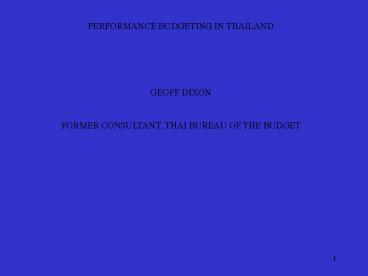PERFORMANCE BUDGETING IN THAILAND PowerPoint PPT Presentation
1 / 22
Title: PERFORMANCE BUDGETING IN THAILAND
1
PERFORMANCE BUDGETING IN THAILAND GEOFF
DIXON FORMER CONSULTANT, THAI BUREAU OF THE
BUDGET
2
Thai budgeting has been very centralized
- very detailed budget categories
- cash allotments within each budget year
- pre-audit of spending transactions (soft)
3
- This results in
- strong control of the budget bottom line
- but
- weak control of budget composition and
efficiency
4
- The challenge is to improve the TRADE-OFF
between - macro fiscal control, and
- compositional and operational efficiency
How? By introducing performance budgeting
5
PERFORMANCE BUDGETING MEANS 1. Output driven
budgeting
- identifying agency outputs
- costing those outputs
- basing budget allocations on this information
In the Thai case this meant identifying and
costing output classes
6
PERFORMANCE BUDGETING MEANS 2. Empowering
program agencies to manage
- internalizing control of inputs
- providing a predictable funding environment
In the Thai case this meant broader budget
categories MTEF
7
PERFORMANCE BUDGETING MEANS 3. Replacing
external control over inputs with external
control over outputs
- reporting budget-year outputs against budget
preparation assumptions
- introducing broader performance indicators for
policy management
In the Thai case this meant sector experts
helping develop performance indicators
8
Input control
Output control
External control
Internal control
9
Internal versus external control (agency
autonomy)
New Zealand
Aust pre 90s
Thailand
Cambodia
Output versus input control (performance focus)
10
Transitioning to performance budgeting 1. How to
manage change in program agencies?
11
The chicken/egg problem in moving program
agencies from external to internal control
- agency skills are in obtaining resources
rather than internally allocating them
- the Budget Bureau argues that reducing its
controls is therefore dangerous
The result HIATUS
12
The 7 hurdles attempted to break the impasse by
making BOB concessions to an agency conditional
on hurdle standards in 7 areas
- budget planning
- output costing
- procurement management
- budget/funds control
- financial and performance reporting
- asset management
- internal audit
13
The reform process is formalized for each of six
pilot agencies by
- a memorandum of understanding with BOB at the
start of the reform process - a resource agreement with BOB when the seven
hurdles are met
14
Transitioning to performance budgeting 2. How
to manage change in the budget agency?
15
- The focus of BOB control should shift FROM
- whether actual spending is consistent with very
detailed pre-specified categories and conditions
TO - whether agencies use of budget funds in a
freer operating environment is effective
16
The challenge for the Bureau of the Budget
- refocus from agency control to agency analysis
- refocus from amounts of inputs to amounts of
outputs and input- output links
17
The Bureau of the Budget must change from
- an enforcer of rules to
- an evaluator of performance
It is already familiar with this role in budget
preparation The role will need to extend through
to budget execution
18
Transitioning to performance budgeting 3. Is
the hurdle approach migratable?
19
There are two approaches to managing budget
reform in change resistant environments
- sequence the STAGES OF REFORM - output
identification/perf. indicators/devolution /MTEF
- sequence the AGENCIES TO BE REFORMED, with
multi-stage package for each agency upon meeting
hurdle standards
The Thais adopted the second approach
20
This reflected the Budget Bureaus difficulty in
quickly providing technical leadership
- spearhead for reform was six reform focused
agencies
- each had an integrated package of reform
- budgetary freedoms would be granted by BOB
conditional on meeting 7 hurdles
21
The hurdle approach is well suited to Thailand
- progress is possible in program agencies even
though progress is slow in BOB
- hurdle approach is failsafe for BOB and more
likely to win its acceptance
- there is a stronger incentive package for
individual agencies to reform due to hurdle
conditionality
- it provides an integrating framework for
different reforms required in budget and program
agencies
22
- In countries in which the budget bureau itself
has achieved critical reform momentum the
alternative of - sequencing by reform stages (each stage
simultaneously introduced across all agencies)
rather than - reform agencies (each of which is offered a
multi-stage reform package when hurdles are
met) - should be considered

